Introduction
The Tryx sports an innovative frame that rotates freely from the rest of the camera, allowing for nearly limitless ways to hang, mount, handle, and hold your new point-and-shoot camera. This isn't a camera with bags of custom options or impressive performance, but its design at least forces you to re-think what kind of shots your camera is capable of capturing.
Front
{{section_header}}{{section.name}}{{/section_header}}

Back
{{section_header}}{{section.name}}{{/section_header}}

Sides
{{section_header}}{{section.name}}{{/section_header}}

Top
{{section_header}}{{section.name}}{{/section_header}}

Bottom
{{section_header}}{{section.name}}{{/section_header}}

In the Box
{{section_header}}{{section.name}}{{/section_header}}

Inside the Casio Tryx's handsome packaging you receive the camera and:
*Quick Start Manuals
*USB-AC adapter
*USB cable
*AC power cable
*Strap
Color
{{section_header}}{{section.name}}{{/section_header}}
We found the Casio Tryx produced images that maintained good color accuracy in the automatic mode, with colors that were neither too vibrant nor too muted. The Tryx had a mean color accuracy error of 3.36, with saturation at 98.35%—very accurate scores for a point-and-shoot camera. We were surprised by the lack of color modes, with only an HDR Art mode that combined images to create an artistic look. More on how we test color.
The Tryx had the most accurate color scores of any of our comparison cameras, beating out the Canon 500 HS, Samsung TL225, and Nikon S4000. Its colors were very accurately saturated, with only minimal error. The other cameras in our group all favored oversaturated, vibrant colors in their automatic modes. The other cameras in our comparison group all gained extra points for their selection of color modes, however, which the Tryx lacked.
Color Modes
{{section_header}}{{section.name}}{{/section_header}}
There were none of the extra traditional color modes that we have come to expect. The only mode on offer that altered color in any significant way was the HDR Art mode, which created an oversharpened, stylized looks that upped contrast and oversaturated colors. Otherwise, users are limited to just utilizing the auto and "premium" auto modes, which handle the color decisions in the background with no user input.
Noise
{{section_header}}{{section.name}}{{/section_header}}
Noise stayed right around 0.7% for most ISO settings on the Casio Tryx, though it spiked upward at ISO 1600 to just over 1%. At ISO 3200 noise reduction really takes over, with noise and image detail obliterated by the camera's image processing. there are no options on the camera to reduce noise reduction, though it seems to be applied only slightly at ISO 100. More on how we test noise.
In low light testing, the Casio Tryx produced images that were about 20% noisier than those taken in bright light conditions. With noise reduction being applied at nearly every setting, however, these totals only crossed the 1% threshhold at ISO 1600. These are very good scores if you're only considering the amount of noise in your images, but the amount of detail sacrificed to get those scores leaves you with some rather poor photos.
The Tryx had the lowest noise totals of any of the cameras in our comparison group. This would normally be a great thing, but the camera accomplishes this by applying heavy noise reduction filtering, resulting in smeared images that lose a great deal of detail. The Canon 500 HS and Samsung TL225 both preserve the most amount of detail through their maximum ISO speeds of 3200, with the Canon just pulling ahead at the maximum. The Nikon S4000 has the noisiest images from ISO 800 and up, but it preserves more detail than the Tryx.
{{comparison_bars title="Noise Score Comparison", attribute="Noise Score", xLabel="Noise Score"}}
ISO
{{section_header}}{{section.name}}{{/section_header}}
The Casio Tryx features an auto ISO and user-selected ISO speeds of 100-3200, in full stop increments only. Somewhat confusingly, the ability to set ISO (as well as other settings, such as white balance) is only available in "Auto" mode, rather than "Premium auto." Typically, a premium or program auto mode would set exposure automatically, but allow users to make other adjustments manually. There is also no way to cap the automatic ISO to a specific speed and there are no options for limiting or turning off noise reduction.
NOTE: The images above are not used in our testing or scoring, but are included here to show real-world examples of the differences between cameras at the various ISO settings.
Resolution
{{section_header}}{{section.name}}{{/section_header}}
The Casio Tryx makes the bold step of eschewing optical zoom in favor of a 3.8mm wide-angle prime lens. We found that the lens, being wider than what most point-and-shoot cameras have, had an acceptable amount of distortion, with average chromatic aberration. It was not a particularly sharp lens—despite being a prime lens—but the Tryx applies sharpening liberally to all its images, so contrast is still fairly high. More on how we test resolution.
Distortion ({{product.raw_scores['Distortion Score']}})
At its maximum aperture of f/2.8 and wide 3.8mm focal length, we found that the Tryx produced images that had a 1.76% barrel distortion. This isn't unexpected, given how wide this lens is, so these aren't terrible results. The distortion is most noticeable when the camera is placed close to an object in the center of the frame, so you'll want to stand at least a few feet away from your subject. The Nikon S4000 and Samsung TL225 fared slightly better, with the Canon 500 HS suffering from greater distortion. It should be noted those cameras all feature optical zoom, however, and thus have more complicated lens structures.
Sharpness ({{product.raw_scores['Sharpness Score']}})
We found the lens to be fairly soft, particularly for a prime lens. Casio combats this by applying some fairly heavy sharpening to the images captured through the lens, resulting in haloing around most areas of contrast. It's not applied uniformly, but seems to mostly occur in the middle of the frame. Compact camera lenses are rarely very sharp, though, and none of our comparison cameras performed much better.
Chromatic Aberration ({{product.raw_scores['Chromatic Aberration Score']}})
We also found that the Tryx suffered from chromatic aberration, particularly in the form of blue and purple fringing around the edges of high-contrast areas such as tree branches against a white sky. This isn't uncommon in a point-and-shoot camera, but it can be distracting at times. There is also considerable light falloff at the edges of the frame.
Quality & Size Options
{{section_header}}{{section.name}}{{/section_header}}
The Tryx features a number of quality and size options, ranging from VGA (0.3-megapixel) resolution up to 12-megapixel still images.
Image Stabilization
{{section_header}}{{section.name}}{{/section_header}}
The Tryx does no feature any image stabilization, optical or otherwise. Its unique design does make for somewhat more stable shooting, however, especially as the frame can be rotated out to be used like the pistol grip on many camcorders. More on how we test image stabilization.
The Casio Tryx does not feature image stabilization, but the other cameras in our comparison group do. The Nikon S4000 benefited the most from its image stabilization in our shake testing, with the Canon 500 HS and Samsung TL225 both seeing only marginal improvement in image sharpness.
{{comparison_bars title="Stabilization Score Comparison", attribute="Stabilization Score", xLabel="Stabilization Score"}}
Video Mode
{{section_header}}{{section.name}}{{/section_header}}
Video on the Casio Tryx is quite good for a point-and-shoot camera. It shoots 1080/30p video, but falls a bit behind what entry-level pocket camcorders produce. There is no optical zoom or stabilization on the Tryx—and only really an automatic mode to rely on—but the results are quite sharp. There is no tripod mount on the Tryx, but utilizing the camera's frame like a pistol grip kept video relatively stable.
Video Color
{{section_header}}{{section.name}}{{/section_header}}
We found that the Tryx produced substantially higher color error in video mode, with colors far more oversaturated than we saw in still images. In testing utilizing a Chroma Du Monde chart, the Tryx's video had a color error of more than 13 (we typically see less than 5 on video, though the Samsung TL225 was worse), with saturation at a vibrant but innaccurate 113.5% of the ideal. More on how we test video color.
{{comparison_bars title="Video Color Score Comparison", attribute="Video Color Score", xLabel="Video Color Score"}}
Video Sharpness
{{section_header}}{{section.name}}{{/section_header}}
We found the prime lens of the Casio Tryx able to resolve detail in video fairly well, with an average sharpness of 525 lw/ph horizontally and 550 lw/ph vertically. These are average results for a camera of this type. Overall, the lens isn't bad for sharpness, but the lack of any optical zoom is hard to overlook. More on how we test video sharpness.
{{comparison_bars title="Video Color Sharpness Comparison", attribute="Video Sharpness Score", xLabel="Video Sharpness Score"}}
Playback Mode
{{section_header}}{{section.name}}{{/section_header}}
Like most of the menu options on the Casio Tryx, the playback mode is simply laid out and easy to use. The menu is as legible as it is on the rest of the camera, with a solid basic slideshow functionality. We would certainly like to see a wider selection of playback modes and options here. A lack of some hardware functionality—optical zoom, image stabilization, continuous shooting—can be explained by the Tryx's unique design demands, but a lack of software functionality in a camera so expensive simply comes off as lacking.
In-Camera Editing
{{section_header}}{{section.name}}{{/section_header}}
There are not very many options for editing in-camera with the Casio Tryx. Users are essentially limited to rotating still images and trimming the beginning or ending of video clips. There are no options to resize images, apply color filters, or reduce red-eye.
Direct Print Options
{{section_header}}{{section.name}}{{/section_header}}
The Casio Tryx is compatible with PictBridge compatible printers, though there does not appear to be any support for DPOF standards. Nearly any photo kiosk at your local drug store should be able to print off the SD card with little issue, though.
Display
{{section_header}}{{section.name}}{{/section_header}}
The Casio Tryx has a 3-inch touchscreen LCD that appears quite clear. It has a resolution of 460k dots, but is quite high in quality and is easy to use. There is a small hitch in responsiveness near the edges of the LCD when dragging through a menu, but it works quite well overall. The LCD can rotate horizontally away from the frame and lens, but also vertically in order to facilitate shooting at extreme angles.

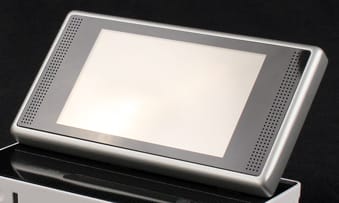
...but it turns into a nice 3-inch widescreen in playback mode.
Flash
{{section_header}}{{section.name}}{{/section_header}}
There is no traditional flash on the Casio Tryx. Instead, an LED lamp is placed on the front of the camera, as you can see in the lens photo below. It's not a terrible replacement, as we normally don't recommend using a point-and-shoot's built-in flash unless absolutely necessary anyway. Still, it washes colors out significantly and tends to exacerbate the vignetting already present in the lens, resulting in dark corners of the frame.

The flash emitter pops up from the top of the body via a mechanical release.
Lens
{{section_header}}{{section.name}}{{/section_header}}
The lens on the Casio Tryx is not particularly sharp and, with no optical zoom, it does not telescope out from the body or make use of a lens cap. Unlike some other cameras that feature internal lenses, there is no way to cover up the glass in front of the lens, so you'll want to keep the camera bagged up so it doesn't get scratched in your pocket.

There is no optical zoom on the Casio Tryx, with the company instead offering a 4x digital zoom (titled the Tryx's "Premium Zoom") or a full digital zoom of 15.9x with a reduced resolution of 640x480 (VGA). The lens otherwise has a 3.8mm focal length, which is the 35mm equivalent of a 21mm lens.
Battery
{{section_header}}{{section.name}}{{/section_header}}
The battery on the Casio Tryx is a lithium-ion rechargeable, but it is built-in, charging via USB or by wall outlet with the included AC/USB charger. The battery is not user-replaceable, as far as we could tell, and has a maximum life of approximately 220 shots by CIPA standards.

Memory
{{section_header}}{{section.name}}{{/section_header}}
The Casio Tryx makes use of SD/SDHC/SDXC memory cards, with 34.8MB built into the camera itself. You'll want to certainly use an external memory card, as 35MB is only enough for a few pictures before it's full. There is also support for Eye-Fi SDHC cards, with instructions in the manual on how to properly set them up with the Tryx.

Jacks, Ports & Plugs
{{section_header}}{{section.name}}{{/section_header}}
The Tryx hides two output ports beneath the rotating frame for USB and Micro-HDMI output. The camera is capable of outputting 1080/60i, 480p, and 576p. There is no 1080/50i option, so in PAL areas the Tryx will need to be switched to output 576p if the television does not support 1080/60i.
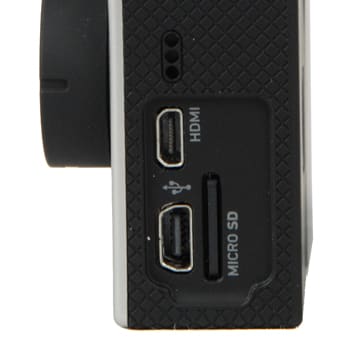
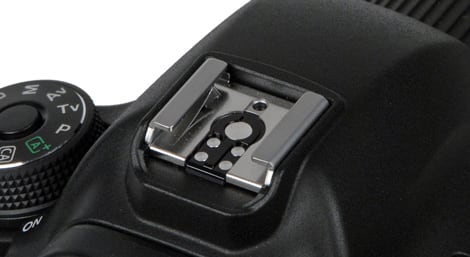
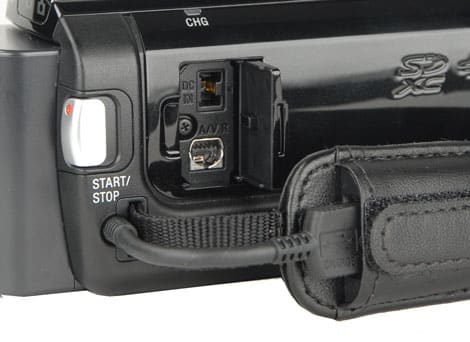
The DC-input and multi-AV port are located on the right side of the camcorder.
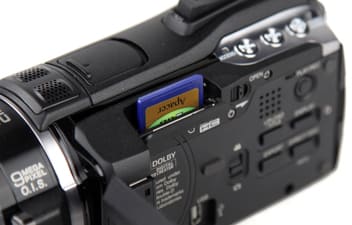
... as is the SD/SDHC card slot.
Shooting Modes
{{section_header}}{{section.name}}{{/section_header}}
There are only a few shooting modes on the Casio Tryx: auto, premium auto, best shot, HDR art, slide panorama, and motion shutter. Selecting the best shot mode allows the user to then choose between High Dynamic Range, Multi SR Zoom, High Speed (Best Selection), High Speed (Night Scene), and High Speed (Anti-shake).
Many of these modes involve taking multiple rapid exposures and then either combining them or selecting the shot that best suits that mode's goal—either getting the shot with the least amount of blur or camera shake, or combining images to achieve greater dynamic range.

The full mode dial is nice, but frequently rotates by accident.
Picture Effects
{{section_header}}{{section.name}}{{/section_header}}
Manual Controls
{{section_header}}{{section.name}}{{/section_header}}
There are very few manual controls on the Casio Tryx, with the camera really only offering white balance, minimal ISO control, some exposure compensation, and the ability to select autofocus type. There is no manual focus, no auto ISO cap, shutter or aperture selection.
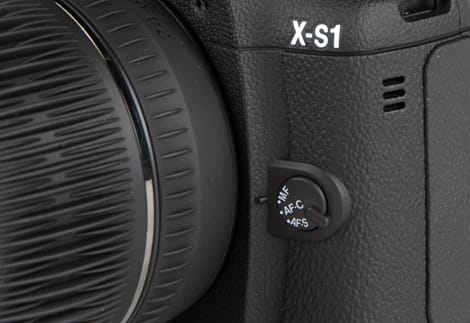
A dedicated focus-mode switch on the front panel.
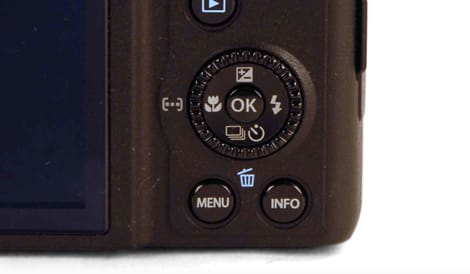
The scroll wheel surrounding the d-pad is neither awful nor perfect.
Drive/Burst Mode
{{section_header}}{{section.name}}{{/section_header}}
The Casio Tryx features several ways to trigger the shutter, but no way to trigger it continuously. It does have a high-speed still and video mode and the ability to take a panoramic image from many continuous shots, but that's it. There is a two and 10-second self-timer available, as well as a motion timer that triggers when something in a particular area of the frame moves. The motion timer works, but a little too well: it often goes off the moment the camera moves more than a fraction of an inch.
Shot to Shot ({{product.raw_scores['Shot to Shot Score']}})
The Casio Tryx does not feature a simply continuous shooting mode, electing instead to offer continuous shooting only in the form of a panorama or as a Best Shot selection. The motion shutter is capable of shooting multiple pictures in a row, but it will have to detect motion in the frame each time, with a maximum of six total shots.
Handling
{{section_header}}{{section.name}}{{/section_header}}
The obvious talking point with the Tryx is the ability of its frame to swing entirely independent of the LCD screen and lens, giving users something to hold or hang the camera by. That gives the user no end of options when it comes to getting exactly the shot they desire. It can be used as a handle to hang the camera by, as a grip to stabilize during video shooting, or even as a makeshift tripod—useful since the camera does not come with a tripod mount as a result.

The LCD also operates on a hinge of its own, meaning that it can be rotated to nearly any angle. This makes self-portraits a breeze since not only can the camera become its own tripod, but the LCD can flip around to become entirely front-facing. From there, the Tryx handles much like a typical touchscreen camera. It has very few physical controls and a number of touch-centric control elements. Its menu is entirely touch-controlled.

The frame's best use may be as a makeshift grip reminiscent of how small consumer camcorders are held. As a result, the Tryx may be the first point-and-shoot camera we've tested where video recording is actually its best function. It lacks image stabilization, but with proper form and the frame design, your videos will be more stable than what just about any other compact can offer. The only real drawback of the frame is that it does not have any way to mount to a tripod, though it is stable enough to act as one in a pinch.


These dedicated buttons give you quick access to aperture and shutter speed controls.
Buttons & Dials
{{section_header}}{{section.name}}{{/section_header}}
There are almost no physical buttons on the Tryx at all. There is merely a power switch and then a shutter release button on the right side of the LCD. The shutter release button is sensitive, and it takes a little more time than usual to adapt to the pressure required for a "half-press" to lock exposure and focus in place.


Menus
{{section_header}}{{section.name}}{{/section_header}}
The menu on the Tryx is pleasantly laid out, with each menu option alternating in background color to improve legibility and touchscreen accuracy. The text is clean and readable, with touch control more accurate than we expected.
Manual & Learning
{{section_header}}{{section.name}}{{/section_header}}
The Tryx doesn't provide much for printed literature with the camera. There is a quick start manual that will help you get the camera up and running, but you'll have to turn to the full manual if you want to learn more about the individual modes and options. The full manual, available online, isn't exactly War and Peace, but it's definitely more thorough, going over the camera's features and offering small tips on getting better images.
Samsung TL225 Comparison
One thing sets the Nikon S4000 apart from the other three touchscreen cameras in our comparison group: price. While they all offer similar performance, handling, and features (minus a few exceptions), the Nikon weighs in at half the price of the other cameras. That's no small difference, as all these cameras are intended to be fun for snapshooters rather than the tools of a serious photographer.
The Casio Tryx does have a few things over the Nikon: it boasts a higher resolution screen, its signature frame design, and full HD video. The Nikon offers similar image quality, better resolution, optical zoom, smaller size, and more than a few picture effects and color modes that the Tryx curiously lacks.
If you're just in the market for a compact touchscreen camera that you can toss in your pocket, the Nikon is the better value. If the handle design of the Tryx intrigues you, then consider giving it a shot. At a $130 price difference, though, that's one expensive feature you'll be buying.
Canon PowerShot ELPH 500 HS Comparison
The Samsung TL225 and Casio Tryx both have designs that are great for self-portrait shooters. While the Samsung elects for a small 1.5'' LCD on the front of the camera to assist with framing, the Casio literally rotates the entire body of the camera to offer its full 3'' LCD for the same purpose.
The Casio and Samsung both have large touchscreens, but the menu on the Tryx is easier to navigate and better organized. The Tryx is lacking in features, however, with many staples of compact cameras in this price range—color modes, creative effects, and some manual controls, to name a few—all absent from the Tryx's repertoire.
The Samsung TL225 is slightly outscored in some of our tests by the Casio Tryx—namely in those that rely on sharpness and noise totals—due to how heavily the Tryx processes images after capture. The scores might be impressive, but the pictures usually are not. By ISO 1600, images from the Tryx are so smeared that fine detail is all but extinguished. The Samsung, by comparison, certainly has to cope with higher levels of noise, but retains a greater measure of detail.
The Casio produces more accurate colors and less noise, but smudges out most of your detail at the highest ISOs. The Samsung offers greater detail and much more control. You'll have to deal with a more frustrating menu design on the Samsung, but you'll get better options to control image quality.
COMP 3
You have to respect Casio for its decision to go bold with the Tryx's design. It's a little odd at first, but it's certainly a functional element that enhances the shooting experience. The Canon 500 HS, by comparison, offers little in the way of innovation in design.
With that said, the Canon 500 HS is simply a better camera for the money. While the Tryx handles better in the majority of situations, it's ultimately undone by picture quality that is bested by the Canon 500 HS.
The Tryx is a fun camera, with a design that immediately gets users thinking about the new and different shots they can take. That initial creativity is ultimately stymied by a lack of color modes and other creative options that have simply become the norm for cameras of this type, and at this price point.
The Canon 500 HS, for comparison's sake, offers many of these modes in a camera that has a higher resolution screen, better image quality, and a simpler shooting experience. The Tryx shouldn't be the last camera that boasts this type of creative design—as it certainly shows promise—but doesn't match the 500 HS in the one area that is paramount for cameras of any type: image quality.
Conclusion
We simply have to applaud Casio for their design of the Tryx. Where most camera companies are falling over themselves to release the same cameras with, at best, minimal improvement, Casio has spared no innovation in the design of this camera.
The rotating frame design, while jarring to see at first, makes video recording a far easier prospect than it has been with just about every other compact camera we have seen. That same design also makes the Tryx the easiest camera for taking self-portraits, emulating the design of smartphones with front-facing cameras and large screens. It isn't a perfect design—the lack of a tripod mount and any sort of optical zoom certainly stand out—but it's a bold step.
Despite these positives, the Tryx is undone by sub-par image quality at high ISOs, a lack of creative color modes, and noise reduction that is applied with a conviction that borders on pure malice. The noise reduction on the Casio Tryx eliminates noise, sure, but it also eliminates any semblance of contrast or fine detail. Like many other features on the camera, noise reduction cannot be turned off or reduced on the Tryx.
The main opponent to the Tryx here is its own price. If this were a $150 camera with slightly less noise reduction, it would be a solid option for compact camera shoppers. At its current MSRP of $250, the Tryx simply doesn't have the image quality chops to stay with most of its competition in the market.
We'd like to see this line of camera design continue, and maybe the Tryx 2 can tone down the noise reduction and do justice to the improvement in handling and design that Casio has presented here.
Photo Gallery
{{photo_gallery "Front Photo", "Back Photo", "Sides Photo", "Top Photo", "Bottom Photo", "Lens Photo", "Flash Photo", "EVF Photo 1", "EVF Photo 2", "LCD Photo 1", "LCD Photo 2", "Media Photo", "Modes Photo", "Manual Controls Photo", "Manual Controls Photo 2", "Other Controls", "Buttons 1", "Buttons 2", "Other Hardware Photo", "Battery Photo", "Ports Photo 1", "Ports Photo 2", "Ports Photo 3", "Ports Photo 4", "Handling Photo 1", "Handling Photo 2", "Handling Photo 3", "Box Photo"}}
Meet the tester
TJ is the former Director of Content Development at Reviewed. He is a Massachusetts native and has covered electronics, cameras, TVs, smartphones, parenting, and more for Reviewed. He is from the self-styled "Cranberry Capitol of the World," which is, in fact, a real thing.
Checking our work.
Our team is here for one purpose: to help you buy the best stuff and love what you own. Our writers, editors, and lab technicians obsess over the products we cover to make sure you're confident and satisfied. Have a different opinion about something we recommend? Email us and we'll compare notes.
Shoot us an email
